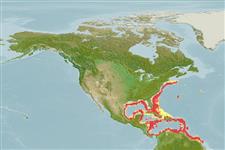Environment: milieu / climate zone / depth range / distribution range
ນິເວດວິທະຍາ
ສັດທະເລ ກ່ຽວກັບ(ຢູ່)ຊັ້ນນ້ຳໃນທະເລທີ່ເໜີອພື້ນດິນ; ບໍ່ມີການເຄື່ອນຍ້າຍ; ລະດັບຄວາມເລິກ 80 - 1170 m (Ref. 1371), usually 160 - 640 m (Ref. 1371). Deep-water; 42°N - 4°N, 98°W - 50°W (Ref. 58452)
Western Central Atlantic: Georges Bank, New England to Suriname and French Guiana.
Length at first maturity / ຂະໜາດ / ນ້ຳໜັກ / Age
Maturity: Lm 28.0 range ? - ? cm
Max length : 40.6 cm TL ຕົວຜູ້/ບໍ່ມີເພດ; (Ref. 1371); 70.0 cm TL (female); common length : 30.0 cm TL ຕົວຜູ້/ບໍ່ມີເພດ; (Ref. 1371); common length :45 cm TL (female); ນ້ຳໜັກສູງສຸດທີ່ເຄຍຈັດພີມມາ: 0.00 g
ຄີ (ໜາມ)ແຂງຢູ່ຫຼັງປາ (ທັງໝົດ) : 1; ຄີຫຼັງຂອງປາ (ຄີອ່ອນ) (ທັງໝົດ) : 45 - 51; ຄີ(ໜາມ) ແຂງຢູ່ຄີກົ້ນປາ
ກຸ່ມປາກະດູກແຂງ
ຄວາມຖີ່ຂອງກຸ່ມຖ່າຍທອດພັນ
ປາທີ່ມີການເຄື່ອນຍ້າຍຈາກທະເລໄປຫານ້ຳຈືດ ແລະນ້ຳຈືດຫາທະເລ
ປາທີ່ມີການເຄື່ອນຍ້າຍຈາກທະເລແລະໄປໄຂ່ຢູ່ນ້ຳຈືດ
ຄີກົ້ນຂອງປາ
ສັດທີ່ມີກະດູກສັນຫັຼງ
ການຖ່າຍທອດທາງກຳມະພັນຈາກພໍ່ແມ່ຫາລູກ: 0; ຄີກົ້ນຂອງປາ: 35 - 41; ສັດທີ່ມີກະດູກສັນຫຼັງ: 51 - 53. Head rather long; mouth large; gill rakers short and thick, with blunt tips; pectoral fin tips reaching a vertical through anus in small fish but not in larger ones; overall color silvery white (Ref. 1371).
Offshore species which inhabit the outer part of the continental shelf and upper part of the slope. Feed at night when they come up towards the surface (Ref. 1371). Juveniles feed primarily on crustaceans (Ref. 58452). Adults' food consists primarily of fishes (particularly lantern fishes, sardines and anchovies) and, to a lesser extent, crustaceans and squids (Ref. 1371). Spawning occurs near the bottom at 330-550 m depth range from April to July in New England and from late spring to early autumn in the Gulf of Mexico and the Carribean Sea (Ref. 58452). Marketed fresh, frozen and smoked.
Cohen, D.M., T. Inada, T. Iwamoto and N. Scialabba, 1990. FAO species catalogue. Vol. 10. Gadiform fishes of the world (Order Gadiformes). An annotated and illustrated catalogue of cods, hakes, grenadiers and other gadiform fishes known to date. FAO Fish. Synop. 125(10). Rome: FAO. 442 p. (Ref. 1371)
IUCN Red List Status (Ref. 130435)
Threat to humans
Harmless
Human uses
ການປະມົງ: ທີ່ເປັນການຄ້າໜ້ອຍ
ເຄື່ອງມື
Special reports
Download XML
ແຫຼ່ງອີນເຕີເນັດ
Estimates based on models
Preferred temperature (Ref.
123201): 7.1 - 20.5, mean 12.6 °C (based on 182 cells).
Phylogenetic diversity index (Ref.
82804): PD
50 = 0.5000 [Uniqueness, from 0.5 = low to 2.0 = high].
Bayesian length-weight: a=0.00759 (0.00453 - 0.01269), b=3.01 (2.86 - 3.16), in cm total length, based on LWR estimates for this species & (Sub)family-body (Ref.
93245).
ຊັ້ນເຂດຮ້ອນ (Ref.
69278): 3.4 ±0.0 se; based on diet studies.
Generation time: 2.3 ( na - na) years. Estimated as median ln(3)/K based on 2
growth studies.
ຄວາມຢືດຢຸ່ນ (Ref.
120179): ຂະໜາດກາງ, ປະຊາກອນຕຳ່ສຸດທີ່ໃຊ້ເວລາສອງເທົ່າ 1.4 - 4.4 ປີ (Assuming tmax > 3 and tm >=2; K=0.57; Fec=340,000).
Fishing Vulnerability (Ref.
59153): Low to moderate vulnerability (30 of 100).
Climate Vulnerability (Ref.
125649): Low to moderate vulnerability (29 of 100).
Nutrients (Ref.
124155): Calcium = 16.3 [7.2, 65.7] mg/100g; Iron = 0.484 [0.080, 1.352] mg/100g; Protein = 17.2 [15.7, 18.6] %; Omega3 = 0.252 [0.112, 0.506] g/100g; Selenium = 24.9 [9.8, 55.4] μg/100g; VitaminA = 11 [2, 52] μg/100g; Zinc = 0.301 [0.197, 0.490] mg/100g (wet weight);
